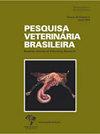高产荷斯坦×吉尔跛行母牛的代谢失衡、蹄损伤和代谢特征
IF 0.8
4区 农林科学
Q3 VETERINARY SCIENCES
引用次数: 0
摘要
摘要:本研究旨在确定高产荷斯坦×吉尔奶牛代谢失衡与跛行或蹄损伤之间的关系,并确定代谢特征是否影响跛行的发生。80头奶牛的产犊期为-60 ~ 60天,分别在-60、7和60天报告了蹄损伤。在第-42、-21、-7、0、7、21、21、42天测定运动评分(LS)、体态评分(BCS)、非酯化脂肪酸、β-羟基丁酸、葡萄糖、胆固醇、白蛋白、总蛋白、血尿素氮(BUN)、钙、磷、镁浓度和天冬氨酸转氨酶活性。McNemar和卡方检验用于比较跛行和蹄损伤的频率随时间的变化,并验证跛行、BCS、蹄损伤和代谢紊乱之间的关联。考虑各组(非跛×跛牛)以及BCS和代谢物随时间的变化,采用双向重复测量方差分析。跛行和蹄伤在第60天和第60天分别增加了20%和66.3%和44.7%和98.6%。产后BCS丢失过多(P=0.017)和亚临床低钙血症(P=0.012)与第60天跛行相关。总的来说,跛牛和非跛牛的代谢谱没有差异,但非跛牛的胆固醇、白蛋白、尿素氮和镁浓度较高。产后BCS的降低会影响跛行的发生,跛牛的代谢谱与非跛牛的差异不大。本文章由计算机程序翻译,如有差异,请以英文原文为准。
Metabolic imbalances, hoof injuries, and metabolic profile of high-producing Holstein × Gir cowsshowing lameness
ABSTRACT: This study attempted to determine the associations between metabolic imbalances and lameness or hoof injuries in high-producing Holstein × Gir cows, and to determine whether the metabolic profile affects the occurrence of lameness. Eighty cows were followed from -60 to 60 days relative to calving and hoof injuries were reported on days -60, 7 and 60. Locomotion score (LS), body condition score (BCS), the concentrations of non-esterified fatty acids, β-hydroxybutyrate, glucose, cholesterol, albumin, total protein, blood urea nitrogen (BUN), calcium, phosphorus, and magnesium, and the activity of aspartate aminotransferase were determined at days -42, -21, -7, 0, 7, 21 and 42. The McNemar and Chi-square tests were used to compare frequencies of lameness and hoof injuries over time and to verify the associations between lameness, BCS, hoof injuries, and metabolic disorders. Two-way repeated measures ANOVA was used considering groups (non-lame × lame cows) and variations of BCS and metabolites over time. Lameness and hoof injuries increased between days -60 (20% and 66.3%) and 60 (44.7% and 98.6%). Excessive postpartum loss of BCS (P=0.017) and subclinical hypocalcemia (P=0.012) were associated with lameness on day 60. In general, the metabolic profile did not differ between lame and non-lame cows but cholesterol, albumin, BUN and magnesium concentrations were higher in non-lame cows. The postpartum decrease in BCS can affect the occurrence of lameness, and the metabolic profile of lame cows shows little difference from that of non-lame cows.
求助全文
通过发布文献求助,成功后即可免费获取论文全文。
去求助
来源期刊

Pesquisa Veterinaria Brasileira
农林科学-兽医学
CiteScore
1.30
自引率
16.70%
发文量
41
审稿时长
9-18 weeks
期刊介绍:
Pesquisa Veterinária Brasileira - Brazilian Journal of Veterinary Research (http://www.pvb.com.br), edited by the Brazilian College of Animal Pathology in partnership with the Brazilian Agricultural Research Organization (Embrapa) and in collaboration with other veterinary scientific associations, publishes original papers on animal diseases and related subjects. Critical review articles should be written in support of original investigation. The editors assume that papers submitted are not being considered for publication in other journals and do not contain material which has already been published. Submitted papers are peer reviewed.
The abbreviated title of Pesquisa Veterinária Brasileira is Pesqui. Vet. Bras.
 求助内容:
求助内容: 应助结果提醒方式:
应助结果提醒方式:


